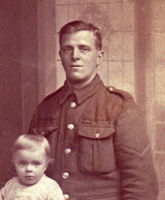
Photograph of William in Tameside Local Studies and Archives Centre. Reference: MR4/17/366

(L to R) Military Medal; British War Medal; Allied Victory Medal
William was born on the 15th March 1891 in Hollinwood in Oldham, Lancashire. His father was called Joseph and his mother was Hannah. He was the oldest of 11 children. We know the names of 9 others; James, Bertha, Joseph, Doris, Amy, Alfred, Ivy, Clarice and Walter. Doris and one other child had died by 1911.
When he was born William and his parents lived at 4 Starting Chair on the outskirts of Oldham. They shared the house with Joseph's mother and step-father James and Caroline Owen. Joseph worked in a coal mine.
Ten years later in 1901 the growing family lived at 4 Nova Scotia Street in Failsworth. They were still here in 1911. Joseph was now a coal heaver, and William had found work as a piecer in one of the area's many cotton mills.
The First World War broke out in August 1914 and William joined the Army towards the end of 1915. We believe he enlisted under the Derby Scheme, where he joined the Army Reserve, and then returned to his civilian home and job until he was called into service. When William was called up he joined the Manchester Regiment and was given the service number 29617. This suggests that he joined the Regiment in around June 1916.
When he was called up William left his home at 128 Gaskell Street in Newton, Manchester and his job as a metal stripper and grinder.
On the 9th September 1916 William married Emily Greenhouse at All Saints Church in Newton. Emily lived at 7 Dixon Street. Between July and September of 1916 their only son Frederick was born.
At some point after this William was sent overseas to France. We don't know exactly when this happened, or which unit he joined, but by mid 1917 he was serving with the 16th Battalion of the Manchester Regiment.
This battalion was based in the Arras area from early 1917 until the end of May, when it moved north to Poperinghe in Belgium.
The 16th Battalion took part in the first day of the Passchendaele Offensive on the 31st July. The battalion attacked towards Polygon Wood and the Zillebeke Bund that morning. To begin with the attack made progress, and the 16th Battalion reached their objective. As the Germans kept firing at the British troops, the next stage of the advance began to slow. Then it started to rain. This turned the battlefield into a sea of mud and water and brought the attack to a halt.
The 16th Battalion lost more than 250 men during the attack. We don't know whether William was wounded, but we do know that he carried out an act of great bravery. He was awarded the Military Medal for it in the London Gazette of the 28th September 1917. Unfortunately his citation has not survived, so we can't say for certain what he did.
The battalion did not return to the front line until the end of the month. After this they served turns in the trenches and in the rear for the rest of the Offensive, which ended in early November. They stayed in Belgium until January 1918.
William was able to return to the UK at some point during late 1917. This photograph of him was taken during that year, and we can see he is wearing his Military Medal ribbon.
Back in France, the 16th Battalion served near Harbonnieres, Moyencourt and Aurigny Rouy before a final tour near St Quentin during the spring of 1918.
By this time William was a member of C Company of the 16th Battalion and had been promoted to Lance Corporal.
By mid March 1918 the British were expecting a German attack. The 16th Battalion was ordered to defend a position called Manchester Hill near St Quentin (it had been named the previous year after its capture by the 2nd Battalion). The Commanding Officer, Wilfrith Elstob, made it clear to his men that they would be resisting a large attack and that they must defend the position 'to the last round and to the last man'.
The attack came at around 6:30am on the 21st March. The Germans heavily shelled the Hill and then launched an infantry attack that was hidden by thick fog. By 11:30am the Germans had broken through and the Hill was surrounded. The attacks continued until a final assault at 3:30pm. Wilfrith was killed shortly afterwards and the survivors surrendered at around 4:00pm.
The men of C Company had not been stationed on the Hill during the fighting. This meant they were more likely to have survived and avoided being taken prisoner than their comrades. This did not mean they escaped without loss, however. The whole battalion lost 78 men killed, and one of them was William. He was 27 years old.
William's grave was never found so his name is one of the 14,656 listed on the Pozieres Memorial in France. William is on Panel 64 to 67.
Emily and Frederick had continued to live at 7 Dixon Street with her parents. She was still here on the 18th October 1924 when she married James Bentley at St Wilfrid's Parish Church. They later moved to 10 Wilton Street in Newton Heath.
We believe Emily died in December 1981 aged 87. William's medals were donated to the Museum of the Manchester Regiment in May 1988.




